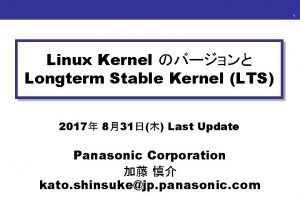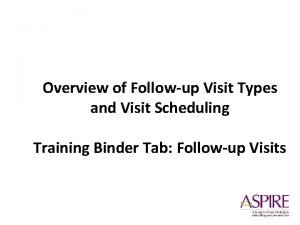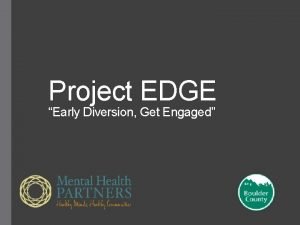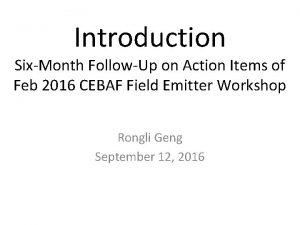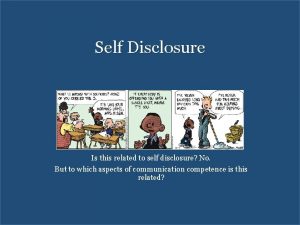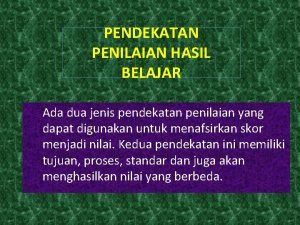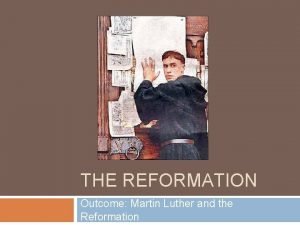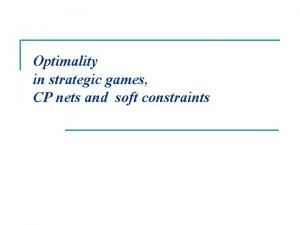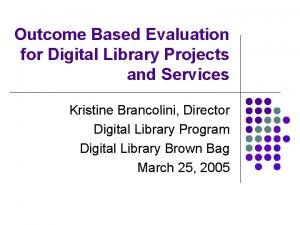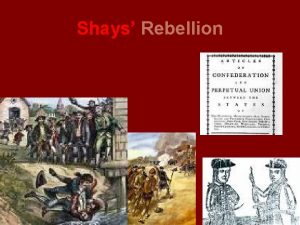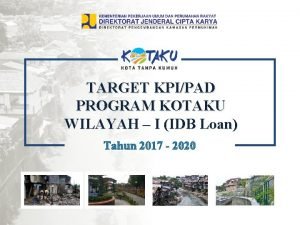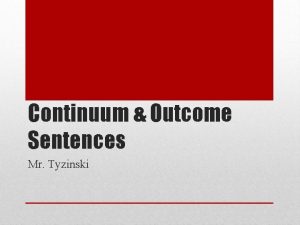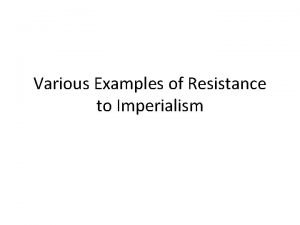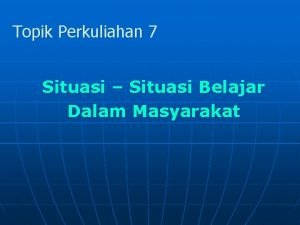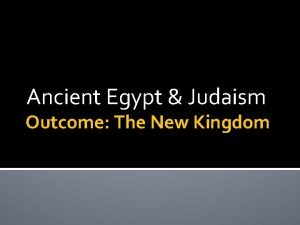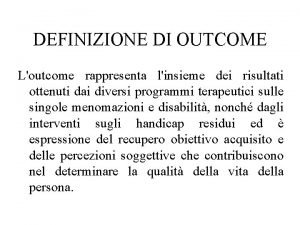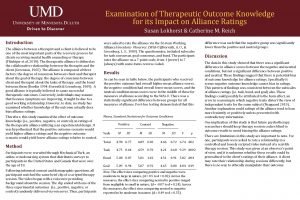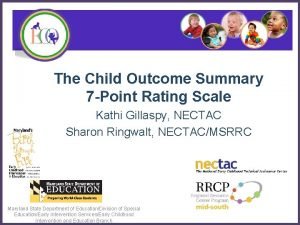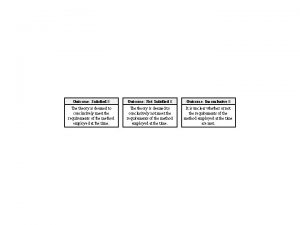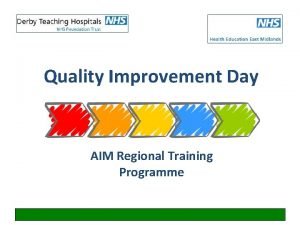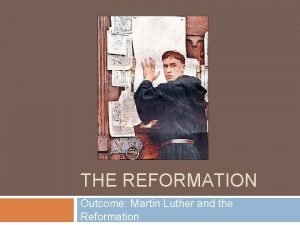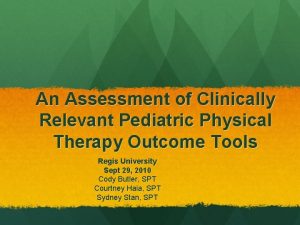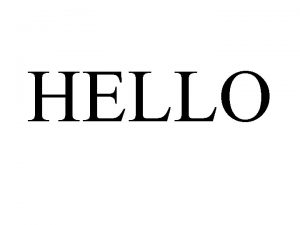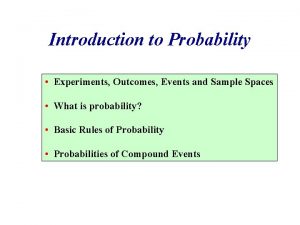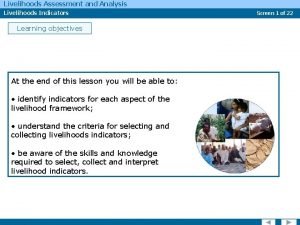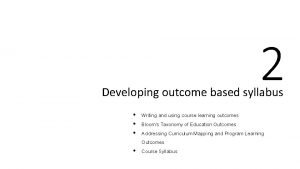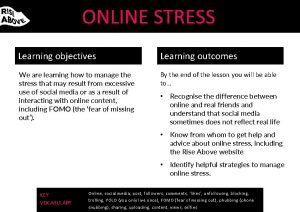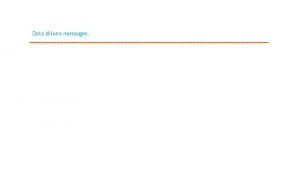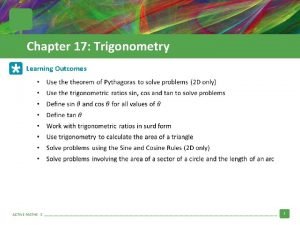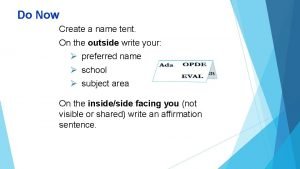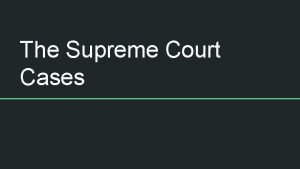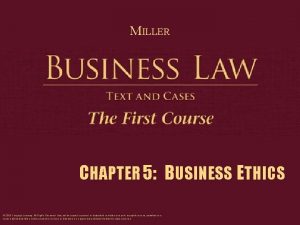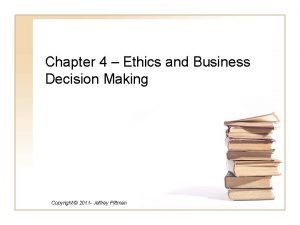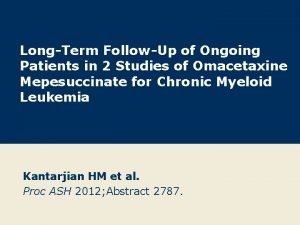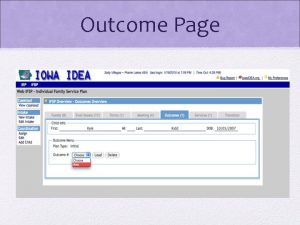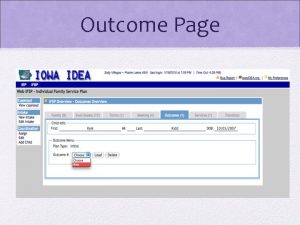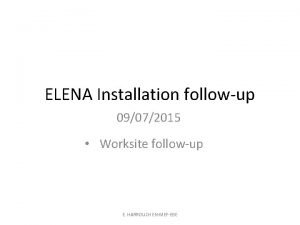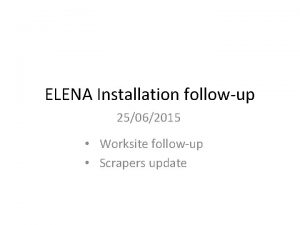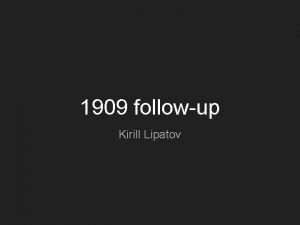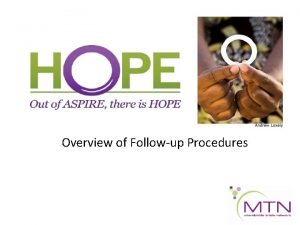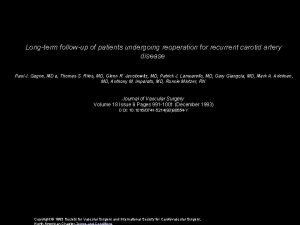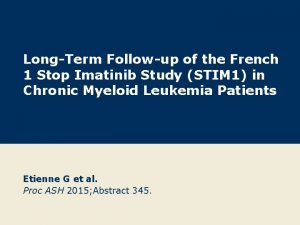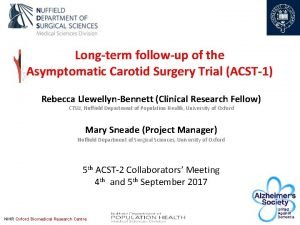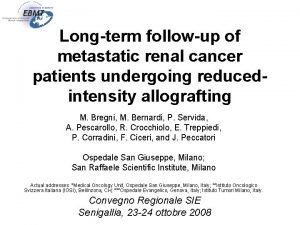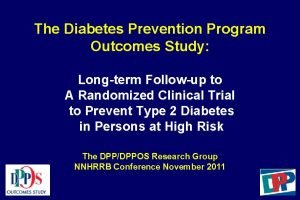Outcome Studies with Longterm Followup Outcome Studies Followup
















































- Slides: 48

Outcome Studies with Long-term Follow-up § Outcome Studies § Follow-up Studies – Mc. Neil et al. , 1991 – Funderburk et al. , 1998 – Eisenstadt et al. , 1993 – Eyberg et al. , 2001 – EFFICACY STUDY – AUSTRALIAN STUDY Nixon et al. , 2003 – AUSTRALIAN STUDY – MAINTENANCESTUDY • Eyberg et al. , 1995 • Schuhmann et al. , 1998 • In progress • Boggs et al. submitted • Hood & Eyberg, 2003 • Nixon et al. , 2003 • In progress

First Long-term Follow-up Study of PCIT § 13 of 20 families participated § Followed 1 and 2 years after treatment § Demographic characteristics – – 100% boys 84% Caucasian Mean age = 4. 7 Median income = $15 K Eyberg, Funderburk, Hembree-Kigin, Mc. Neil, Querido, & Hood (2001) Child & Family Behavior Therapy

§ Effect Size Interpretations g. Small = . 20 -. 40 g. Medium =. 40 -. 60 g. Large =. 60 -. 80 g. Very large =. 80 - 1. 00 g. Astronomical = >1. 00

ECBI Intensity Scores and 2 -Year Effect Size 2. 32 Eyberg et al. , 2001

ECBI Problem Score and 2 -Year Effect Size 2. 47 Eyberg et al. , 2001

Werry-Weiss-Peters Activity Scale and 2 Year Effect Size 1. 39 Eyberg et al. , 2001

Parenting Stress Index Child Domain and 2 Year Effect Size 1. 71 Eyberg et al. , 2001

Parenting Stress Index Parent Domain and 2 Year Effect Size . 70 Eyberg et al. , 2001

DPICS Alpha Compliance and 2 Year Effect Size . 85 Eyberg et al. , 2001

DPICS Deviant Behavior Composite and 2 Year Effect Size . 54 Eyberg et al. , 2001

DPICS Description & Reflection and 2 Year Effect Size . 79 Eyberg et al. , 2001

DPICS Parent Verbal and Physical Negative 1. 11 Eyberg et al, 2001.

Therapy Attitude Inventory Eyberg et al. , 2001

Generalization of Treatment Effects to the School l l e h s t u n In a § Treated children improved more than untreated classroom controls on measures of conduct problems § Less evidence of treatment effect on measures of hyperactivity and social skills Mc. Neil et al. , 1991

SESBI Intensity Scale § Funderburk et al. , 1998

SESBI Problem Scale § Funderburk et al.

Revised Conners Subscales Funderburk et al. , 1998

SOCS Compliance Funderburk et al. , 1998

SOCS Appropriate Behavior Funderburk et al.

SOCS On-Task Behavior Funderburk et al.

Efficacy Study Results … ll e h s t u In a n § Treatment group showed significant improvements in child & parent functioning relative to waitlist controls (except DAS and BDI) § Treatment gains maintained at 4 -month follow-up § Predictors of dropout were maternal distress and observed maternal critical/sarcasm toward child

Boggs 1 - to 3 -Year Follow-up of Efficacy Study § 23 Dropouts § 23 Treatment completers • • 78% boys 74% Caucasian Mean age at pre-treatment = 4. 9 Mean Hollingshead Index = 35 Boggs, Eyberg, Edwards, Rayfield, Jacobs, & Bagner, in preparation

Dropouts Completers p <. 01 Boggs et al.

Dropouts Completers p <. 001 Boggs et al.

Dropouts Completers p <. 001 Boggs et al.

Dropouts Completers p <. 05 Boggs et al.

Dropouts Completers ns Boggs et al.

Follow-up of the Efficacy Study 4 to 6 Years After Treatment § 23 families (completers) – 70% boys – 83% Caucasian – Mean age at pre-treatment = 5. 0 – Mean Hollingshead Index = 40 Hood & Eyberg, 2003

Parenting Locus of Control and 4 -6 Year Effect Size 1. 29 Hood & Eyberg, 2003

ECBI Problem Scale and 4 -6 Year Effect Size 1. 40 Hood & Eyberg, 2003

ECBI Intensity Scale and 4 -6 Year Effect Size (6 children above the cutoff at longterm follow-up) 1. 43

The Maintenance Study § Goal – To prevent relapse for ALL children § Assumptions – Early conduct disorders are persistent and recurrent – Treatments that end as soon as the problems first remit may not consolidate gains sufficiently for all families – Timely boosters my prevent relapse

Design § Participants – Estimated 80 treatment completers § Randomize completers – Two-year Maintenance Treatment (MT) – Follow-up Assessments Only (AO) § Assessments – Six brief quarterly phone assessments – Two major yearly assessments

The Maintenance Treatment § Monthly phone calls provide – Support – Monitoring – Intervention § Monitoring checks on – child behavior problems – parent mood/stress – parent follow-through with PCIT

Three Levels of Intervention Level I (5 -15 minute call) – reinforce parent follow through – brief suggestions if indicated – show concern for parent well-being – encourage continued participation

Maintenance Interventions Level II (15 -60 minutes) – Level I components plus – Address identified problem • Empathic listening • Engage parent problem solving • Outline a plan to solve problem – Brief follow-up call 1 week later

Maintenance Interventions Level III (a clinic session) § When – Monitoring call indicates crisis – Level II problem has persisted – Parent calls and requests clinic session § Involves – Providing support – Problem solving – Observing parent-child interactions and coaching if indicated – Developing a plan

Maintenance Study 1 -1 -03 § 81 families enrolled so far § 22 families dropped out § 19 families currently in treatment § 40 families have completed treatment § 37 families have completed the post assessments èRandomly assigned to either maintenance treatment or control Eyberg & Boggs, 1999 -2004 NIMH RO 1 MH-60632

Families Randomized to Group So Far § Post-treatment – Maintenance Tx - 14 families – Assessment Only - 13 families § 6 -month follow-up – Maintenance Tx - 12 families – Assessment Only - 10 families Eyberg & Boggs 1 -1 -03

Maintenance Study Standard Treatment Results ll e h s t u n In a CBCL Externalizing Scale

ECBI Intensity Scale Eyberg & Boggs

ECBI Problem Scale Eyberg & Boggs

Beck Depression Inventory Eyberg & Boggs

PSI-SF Parental Distress

PSI-SF Parent-Child Dysfunctional Interaction Eyberg & Boggs

PSI-SF Difficult Child Eyberg & Boggs

Conclusions Immediate outcome g. All studies consistent g. Clinically meaningful changes g. Parent and family functioning g. Child behavior at home & school g. Parent-child interactions

Conclusions Long-term outcome g. Very little decline in first year g. Greater decline in second year g 25% back to baseline after fourth year g 75% maintain long-term gains n. Maintenance treatment aimed at the 25% n. May not see differences until 2 nd follow-up year
 Linux kernel lts
Linux kernel lts Follow up visit
Follow up visit Followup edge
Followup edge Followup:actionitems
Followup:actionitems Thomas silverstein art
Thomas silverstein art Paradigm shift from women studies to gender studies
Paradigm shift from women studies to gender studies Predicted outcome value theory
Predicted outcome value theory Pendekatan penilaian hasil belajar
Pendekatan penilaian hasil belajar The reformation outcome martin luther and the reformation
The reformation outcome martin luther and the reformation Counseling outcome research and evaluation
Counseling outcome research and evaluation Pareto optimal outcome
Pareto optimal outcome Outcome based evaluation definition
Outcome based evaluation definition The age of exploration outcome the atlantic slave trade
The age of exploration outcome the atlantic slave trade Shays rebellion outcome
Shays rebellion outcome Indikator outcome kotaku
Indikator outcome kotaku Outcome harvesting training
Outcome harvesting training Use continuum in a sentence
Use continuum in a sentence Effects of american revolution
Effects of american revolution Maji maji rebellion definition ap world history
Maji maji rebellion definition ap world history Required outcome
Required outcome Ancient egypt and judaism outcome the new kingdom
Ancient egypt and judaism outcome the new kingdom Outcomes based education for teacher preparation curriculum
Outcomes based education for teacher preparation curriculum Outcome clinico significato
Outcome clinico significato Input outcome output impact chain
Input outcome output impact chain Therapeutic outcome study
Therapeutic outcome study Child outcome rating scale
Child outcome rating scale Satisfied outcome
Satisfied outcome Intended outcome
Intended outcome The reformation outcome martin luther and the reformation
The reformation outcome martin luther and the reformation Pediatric physical therapy outcome measures
Pediatric physical therapy outcome measures United states v nixon outcome
United states v nixon outcome Learning objectives of poem
Learning objectives of poem Intersection and union of events
Intersection and union of events Cold war outcome
Cold war outcome Exclusive ownership of a key resource
Exclusive ownership of a key resource Outcome thinking
Outcome thinking Livelihood outcome indicators
Livelihood outcome indicators Outcome based syllabus sample
Outcome based syllabus sample Examples of educational goals and objectives
Examples of educational goals and objectives Tinker v des moines outcome
Tinker v des moines outcome Expected output thesis sample
Expected output thesis sample Data driven messaging
Data driven messaging Learning outcome
Learning outcome Dpgt samples
Dpgt samples George w. mclaurin
George w. mclaurin Business ethics 2015
Business ethics 2015 Who won battle of lexington and concord
Who won battle of lexington and concord Learning outcomes generator
Learning outcomes generator Outcome based ethics examples
Outcome based ethics examples
